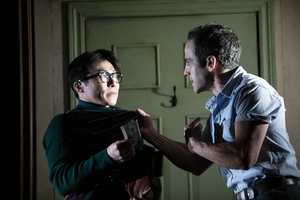Review: THE SEVEN STREAMS OF THE RIVER OTA, National Theatre

![]() A seven-hour piece of marathon theatre may not be everyone's cup of tea. But the demanding length of The Seven Streams of the River Ota brings with it such a dazzling array of perks that it's nearly impossible to resist the challenge of sitting through it.
A seven-hour piece of marathon theatre may not be everyone's cup of tea. But the demanding length of The Seven Streams of the River Ota brings with it such a dazzling array of perks that it's nearly impossible to resist the challenge of sitting through it.
First performed in 1996, Robert Lepage's epic mosaic about the variegated aftermath of the atomic bombing of Hiroshima has long enjoyed the position of a masterwork in the acclaimed Canadian auteur's oeuvre. Its revival at the National Theatre reminds us with force and verve why this remains the case.
For all its meditative posture and predominant mode of stillness, The Seven Streams is a play where a lot happens, narratively speaking. Spanning the period from 1945 to 1999, the work's seven sections portray discrete but interlocking storylines that tend to differ in terms of style, focus, and tone.
There is, however, some sort of a centre to this vast expanse: a house in Hiroshima that stands where the River Ota divides into its seven streams. The play opens here in 1945, during the American occupation of Japan, when an American soldier visits it in order to take photographs depicting the physical damage of the land. His burgeoning affair with the mistress of the house culminates in the birth of a boy, whose subsequent journey towards discovering his filial ties comprises only a part of what the other sections deal with.
By the time the seventh section takes us back to the house, we have made shattering stops in New York, Osaka, Amsterdam, and the Theresienstadt camp, and gotten to know a range of eccentric, quietly tormented characters. These include an adulterous Québecois diplomat and his hammy wife, an avant-garde artist who becomes a Zen monk, an AIDS patient who decides to commit assisted suicide, and a blind translator whose attachment to the house in Hiroshima exudes an uncanny energy.
Written and staged by Lepage's theatre company Ex Machina, this multilingual, multipartite saga patiently pulls the audience into its poignant patchwork of narratives, where it lets a number of thematic concerns gestate elegantly: the entanglements of art, history, and subjectivity, the hall of mirrors created by personal and collective memory, and the possibilities of intimacy and communality occasioned by pain are just a few of these. As the play brings together and reconciles different - perhaps even competing - storylines and theatrical modes, it taps into a plethora of questions with an inclusivity that is at once daring and unassuming.
A breathtakingly versatile cast of 10 actors makes it look as though there were dozens of performers involved in the production. They are uniformly excellent in their often understated but highly differentiated renderings of a wild panoply of personas. Rebecca Blankenship, Christian Essiambre and Audrée Southière particularly astound with the tonal distances traversed by their characters, sometimes within very short spans of time.
Also impressive is the show's masterful design. Lepage's eclectic scenography (credits for which also belong to Carl Fillon and Ariane Sauvé) draws on elements of shadow theatre, projections of historical footage, and a lot of sliding doors. As live music oozes from the traditional Japanese instruments stationed on one side of the stage, cubicles of naturalistic interiors alternate with abstracted set pieces (including a stunning container made of mirrors) - all of which inhabit the physical scale of the house in Hiroshima.
This staggering mélange of visuals is consistently enhanced by Sonoyo Nishikawa's intricately evocative lighting design and Virginie Leclerc's on-point costumes. The whole thing is a delight to behold.
If not all seven streams of Lepage's river are equally captivating, then that's less a structural weakness than an invitation for us to acknowledge the dissimilar ways in which the weight of history seeps through the decades into the present. After all, however different their girths and rhythms may be, all these streams are connected to a central river, a central history of the horrors of World War II, whose merciless, unyielding flow both sustains and destroys, gives and takes away.
The Seven Streams takes us by the hand, lures us into those rivulets, and asks us to reckon with what lies underwater.
The Seven Streams of the River Ota at the National Theatre until 22 March
Photo credit: Elias Djemil-Matassov
Reader Reviews
Videos

